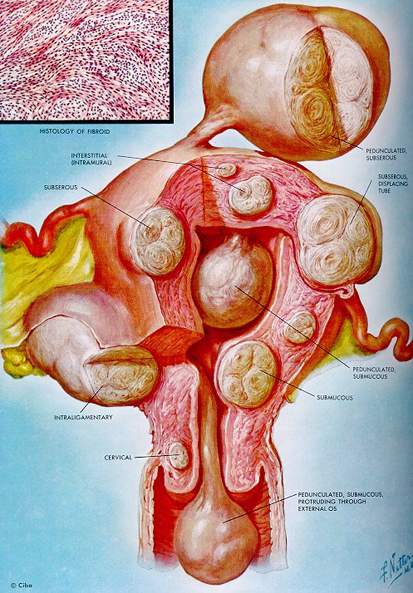Myomectomy
Myomectomy is the surgical procedure in which uterine fibroids are removed from the uterus. Uterine fibroids (also known as myomas) affect at least 30% (up to 70%) of women. While many fibroids do not need treatment, others can cause abnormal uterine bleeding, pain, pressure or other symptoms.
The treatment of Fibroids often involves removing the entire uterus (hysterectomy) but many women want an alternative if they wish to have children or simply do not want to lose their uterus. Unfortunately, many gynecologists are hesitant to recommend myomectomy because it may involve greater surgical risk. As with any procedure, there are both advantages and disadvantages to myomectomy. This site will provide information to help you make an informed decision.
 What information do you need?
What information do you need?
- Types of uterine fibroids. There are 3 major categories of uterine fibroids. Those on the outside surface of the uterus are called subserous. This type of fibroid may twist and cause pain. Fibroids that arise in the wall of the uterus (intramural) may cause pain or abnormal bleeding. Fibroids that are inside the uterine cavity are called submucous and are commonly associated with marked cramping and abnormal irregular or heavy menstrual flow.
- Diagnosis of uterine fibroids. Fibroids are most commonly found during a routine pelvic exam with no ongoing symptoms. Ultrasound is often performed to document the exact size and location of the tumor. if an MRI is ordered is usually by a radiologist preparing to do a fibroid embolization. Sometimes we look inside the uterus with the scope instrument but we usually have other means of knowin in advance if a fibroid is in this location.
- Abdominal myomectomy. Removal of one of these tumors through a large incision in the abdomen is commonly performed if the tumor is extremely large. Depending on its size it may be removed through a vertical or a transverse incision.
Laparoscopic myomectomy. in many cases it is possible to remove a fibroid tumor from the uterus through the laparoscope. This is generally associated with a more rapid recovery but requires special surgical skills including the ability to place stitches inside the abdomen using the laparoscope.
Hysteroscopic myomectomy. Hysteroscopic myomectomy removes fibroids through the cervix without making an incision. it starts to become very difficult if the tumor is larger than a golf ball or deeply embedded in the wall of the uterus. It requires knowledge of special tools and often requires special hand-eye coordination.
Is myomectomy the best choice for me? The most common reason to remove the smooth muscle tumor is if you’re childbearing desires are not complete. Once you have completed your childbearing, using the principles of minimally invasive gynecology it’s possible to remove your uterus and associated fibroid tumors through small incisions that allow for rapid recovery in most cases. A laparoscopic hysterectomy will essentially guarantee you will not have a future menstrual flow.
FAQ Frequently Asked Questions.
- How do I select a surgeon? experience, experience, experience.
- Are fibroids cancerous? about 1 in 400 may be a Leiomyosarcoma.
- Will my fibroids grow back? very slowly if at all. But yes it is possible. They shrink in the menopause.
- What can you tell me about shrinking fibroids with Depo-Lupron®? – Lots of side effects and only a temporary approach usually for fertility purposes.

